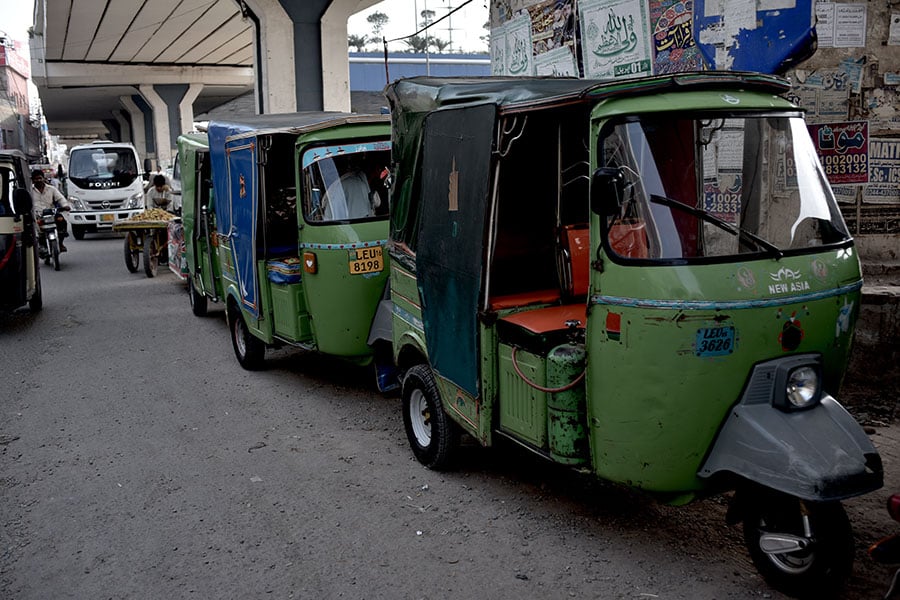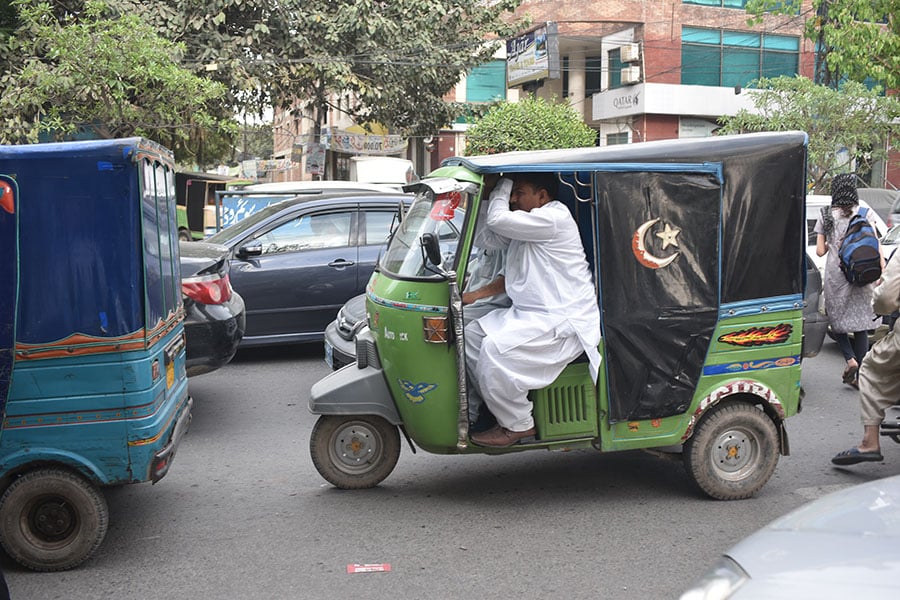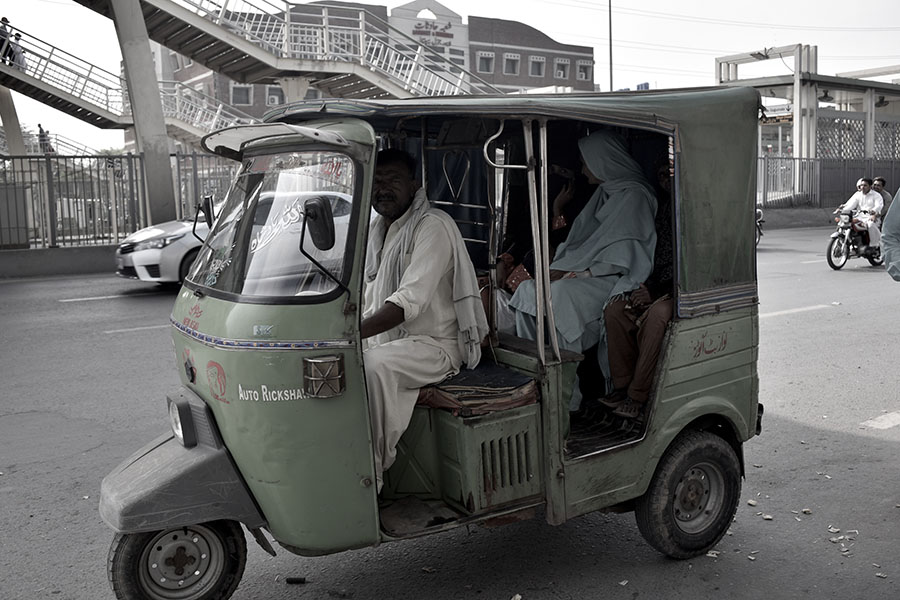It is 9pm. Sunny takes a sharp turn left and then right, balancing his rickshaw, at times, on just two wheels. He manoeuvres through the narrow streets of Samanabad, a middle-class suburb in Lahore, towards a marriage hall in a crowded market corner. When he finally stops, the three passengers dismount. By now, Sunny, a prematurely aged man, is exhausted. The rumblings in his empty stomach have grown louder. But he must wait, on a chaotic roadside. Another customer could be coming.
His days start at 6am from his home in the impoverished Christian neighbourhood of Youhanabad. After dropping his children to school, he prowls the streets in his three-wheeled rickshaw, till midnight. There are no regulated working hours and off-days. Sunny returns home only when he has made a reasonable earning for the day.
Back in Samanabad, an hour has gone by. The crowd in the market has begun to thin out, while Sunny has yet to book a customer. He stares listlessly out of the windscreen, hoping to engage a passenger headed in the direction of his home. A few approach him, but their destinations are either in the opposite way or they disagreed on the fare. Finally, at 10:20pm, he gives up. Revs up the engine and heads home. “This area in Samanabad is always very busy,” he says disheartened, “And yet I couldn’t find a single ride. Not a single person wanted to go in the same direction as I did. How can that be? They must have taken the Uber.”
Rickshaws are a historic mode of transportation in Pakistan that had, until now, survived modernisation. By some accounts, the vehicles were introduced in the late 19th century in India by Chinese traders to transport goods. The first of its kind rickshaws were two-wheeled, pulled by drivers on foot. Eventually, the small vehicles became motorised, as they chugged towards the 21st century. For a long time, this means of transportation was considered the cheapest way to travel intra city. The boom in cars, scooters and taxis had little effect on its business. But now, it seems, rickshaws have finally met their match. ride-hailing apps and dedicated rickshaw hailing apps are fast cutting into its market, in the big cities.
Take Lahore, for example. There are a total of 90,000 privately-operated rickshaws running in the city of 11 million, according to Lahore’s Excise and Taxation Department. These 90,000 rickshaws are at risk of being pushed off the roads.
Till 2016, before ride-hailing apps rolled out their services in Pakistan, rickshaws had a monopoly over the contract carriage market. Fare rates were negotiable and often decided by the drivers and customers on the spot. In those days, Sunny could easily earn Rs 1,500 per day, working from 9am to 12pm. Now, even if he works 13 hours a day, he only manages to take home Rs 1,000 – that too on a good day.
Like other rickshaw drivers, he blames ride-hailing apps for the loss in income. They can offer fares as low as Rs 200. “If you had to travel, and the choice was between an air-conditioned car or a small open carriage, which would you choose?” he asks, “How do we even compete?”
Besides cars, ride-hailing apps also offer rickshaw services to their customers. In Lahore, Pakistan’s second most populous city, the ranks of the ride-sharing game has swelled in just two years. Several startups that connect rickshaws and motorcycles with customers have popped up quickly. A ride through the app of one of these startups, for example, can take a customer from one spot to another for only Rs 5 per kilometre.
Additionally, the drivers who choose to work with the app companies have the opportunity to make a predictable and higher income. Then, there are other perks. These companies pay their drivers bonuses up to Rs 5,000 on days when the volume of rides is low.
But for someone like Nadeem Khan, who never received a formal schooling, joining a multinational company is not an option. “I don’t even know how to read,” he tells Geo.tv, “How will I ever read a map?” Khan is now thinking of selling his rickshaw, which he bought for Rs 175,000 to buy a grocery kiosk instead. While waiting for customers, he notices a traffic policeman making his way towards him. The rickshaw driver quickly kick starts his vehicle and speeds off. The policeman is the third and most potent threat to private rickshaw owners.
The Lahore Transport Company, a traffic regulatory authority, has a new rule. All rickshaws must have a route permit, which costs Rs 2,500 and is only valid for three years at a stretch. “That is a lot of money,” complains Sunny, “And if we forget to renew the permit in time, we have to pay a fine of Rs 200 per day.” The fact that car sharing apps do not have to pay this permit is not lost on the drivers either. “They [the LTC] are trying to promote apps at the cost of our livelihood. Their charges are unfair to poor people.”
But Nasir Hussain, the deputy manager of communications at the LTC, disagrees. “We have issued over 60,000 route permits till now,” he explains from his office in Lahore, “When awarding these permits, we also check the vehicle’s fitness. We must make sure that only safe and environmentally friendly vehicles are on the roads. A lot of these private owners have rickshaws that are powered by gas cylinders, which are illegal and dangerous.”
Inarguably, in the bigger cities, where the ride-hailing apps have launched, the odds are stacked against private rickshaw owners. (In small cities rickshaws are still ubiquitous).
Nonetheless, drivers in Lahore say they are not ready to give up just as yet. A local labour union, the Awami Rickshaw Driver Union, has collected donations to fund their own mobile application, the Awami Swari. The Union also regularly holds protests and organises training sessions to educate drivers on how to use Google maps. But, asking Rs 9 per kilometre with a starting fare of Rs 48, the app seems doomed for failure in the face of much cheaper competitors.
“Everyday, when I wake up, I blame the PITB for our loss,” says Majeed Ghauri, the president of the Union. He is referring to the Punjab Information Technology Board, a government department tasked to digitise the province. “The PITB gave permission to these mobile applications, without consulting us. Now, we only make Rs 1,000 per day, of which we have to pay Rs 350 to the owner of the rickshaw and then there are repair costs.”
The Awami Rickshaw Union is made up of 23,000 drivers in Lahore. In a few months, Lahore will get its first Metro Train, Ghauri went on, “Between that and the approaching summers, we, non-air conditioned vehicles are doomed.”
But even those who are employed by multinational companies are complaining. Samar Masih*, a rickshaw driver with a ride-hailing app, is certain that the future of his three-wheeled ride is not too bright. The 50-year-old admits he would make more money independently than with a ride-hailing service. “Yes, we get bonuses but there is still barely any business,” he explains, “Let’s face it. We are outdated. Rickshaws will be wiped out in another 10 years.”
For many rickshaw drivers, in urban cities, it is a desperate race against modernisation.
Sunny has already asked his children to teach him basic English so he can operate an online map. “I am tired of these long days. But after I learn English, I don’t know if I would want to still be driving a rickshaw.”
*Names have been changed







